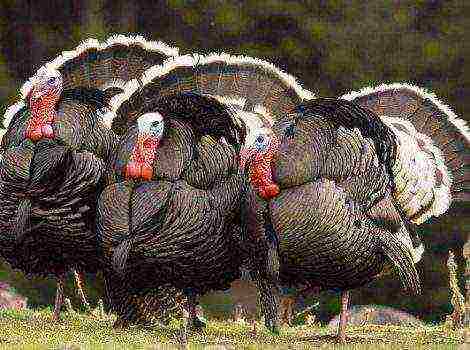Content
- 1 Fluorescent lights for plants
- 2 Growing plants under artificial lighting
- 3 Why do you need additional lighting
- 4 Find out how familiar you are with lighting! Answer 7 questions (test)
- 5 Light characteristics
- 6 Types of lamps
- 7 Incandescent lamps
- 8 Fluorescent lamps
- 9 Discharge lamps
- 10 LED bulbs
- 11 Decorative and plant growth lighting
- 12 The most important component of growth is the light spectrum
- 13 Signs of a lack of light
- 14 How much light do you need?
- 15 Supplementary lighting of plants and artificial light sources
- 16 Which light is best for growth?
- 17 5 useful tips
- 18 Summing up
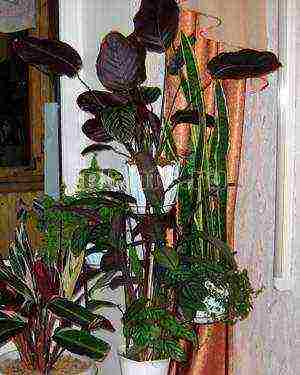
The difference in illumination in summer and winter is so great that there is not enough natural light for plants, unless the temperature drops and the transition to the resting phase does not occur. If in the summer the plants had to be shaded from the hot midday sun with a tulle curtain, then with the onset of autumn it is necessary to rearrange the plants as close as possible to the light, move those plants that stood near the window to the windowsill, those that stood in the center of the room closer to the window. Moreover, if in the summer only plants carrying the sun could be on the sill of the southern window, then in winter almost all plants can be placed on the windowsill of the same southern window, since the autumn and winter sun does not often indulge in its appearance. Shading is needed only on especially sunny days.
How do you know if your plants don't have enough light?
Some people confuse the signs of a lack of light and take them for those when the plant suffers from overdrying of an earthen coma or excessive watering, but if you look closely, you can figure it out. First of all, with a lack of light, shoots begin to stretch out, new leaves are smaller than the old ones and their color is not so bright and saturated. In variegated forms of plants, the color of the leaves from a lack of light becomes more monotonous or completely green. The lower leaves begin to dry out and fall off, the apical buds do not develop. If this is a flowering plant, then the flowers gradually fall off, flowering stops or small, not beautiful flowers are formed. The most common picture is when the plant stops growing altogether, new shoots are not formed, and the old leaves begin to dry out and die off a little. Of course, there are plants that are in a dormant state in winter, while they also do not form new shoots, but old leaves should not die off in large numbers. Rearranging plants closer to the light is not always possible, and not all plants will fit on the windowsill.
Fluorescent lights for plants
Most people make do with artificial lighting, i.e. lighting of chandeliers, lamps, sconces, etc. But not all plants receive such light, in addition, incandescent lamps emit heat, which harms plants if they are close. Therefore, if your plants do not have enough light, use, for example, fluorescent lamps. The lighting from them is as close as possible to natural light and they almost do not emit heat. In addition, fluorescent lamps consume 4 times less energy than incandescent lamps.
There are a wide variety of fluorescent lamps on sale now, so all you have to do is buy and hang. The distance indicated for the placement of plants - 30-60 cm for decorative deciduous and 15-30 for decorative blooming - is very conditional.This means that if there are many lamps and it is very light in the whole room, just like on a clear day in summer, then the plants do not need to be placed so close to the lamps. But if you have one or two lamps, they are clearly not enough for the whole room, and the plants are placed as close to the lamps as possible, at the distance indicated above. If the plant turns out to be located on one side of the lamp, then periodically it must be turned so that the crown remains uniform. If there is not enough lighting even for those plants that stand on the windowsill, then you can hang fluorescent lamps from both sides in the window niche.
Using one 20 W fluorescent lamp, at a distance of 30 cm from a decorative leafy plant, for example, a medium-sized cissus or ficus benjamin, is quite enough to make up for the lack of natural light in autumn and winter.

The duration of artificial lighting directly depends on the natural one. This is usually a few hours in the morning or a few hours in the evening. Those. your fluorescent lights will be on in the morning before you have to leave for work, and in the evening before you go to bed. But in total, this time should be about 6-8 hours. On especially cloudy days until 12 noon. If the day is especially sunny, 3-4 hours of artificial light is sufficient. In order for plants to bloom in autumn and winter, for example, Saintpaulias, they need about 12-14 hours of good continuous lighting.
The quality of flowering and the number of flowers will depend on the length of daylight hours. It should only be borne in mind that most plants need a dormant period and prolonged forced flowering in winter depletes plants (with the exception of winter flowering plants). There is such a concept - photoculture - these are plants grown partially or completely under artificial lighting.
If a large plant, for example, a monstera, is standing on the floor in the corner of a room, the lighting on one side will not be enough or it will not be uniform, but if the lamp is suspended from the ceiling, it may be far from the plant. In this case, you can place one lamp on each of the walls, and put the plant at a distance of 40-60 cm from them, then the lighting will be more uniform and sufficient.
Growing plants under artificial lighting
What to do if there are no windows in the room at all. Many plants can be grown under artificial lighting, but at the same time it is necessary, firstly, to use only fluorescent lamps and, secondly, to correctly observe other modes of care - temperature and water. In addition, such areas should be regularly ventilated. The difference between such plant breeding is that artificial lighting should be as close to natural as possible - continuously for about 12-14 hours in spring-summer, 7-9 hours in winter. It is desirable that not only the plant (s) be illuminated, but the entire room. Such conditions most often occur in offices and work spaces, where many fluorescent lamps are suspended from the ceiling and the room is well lit.
Basically, plants that do not require direct sunlight are suitable for growing under artificial lighting conditions only. Those. these are plants suitable for growing on east, west and north windows. For placement in a room where there is no natural light, you can use the fern nephrolepis, tradescantia, dracaena bordered, ficus elastica (rubbery), asparagus Sprengeri, scindapsus, philodendron, pandanus, peperomia, monstera, etc. From flowering plants, Chinese rose, gloxinia, pelargonium, uzambara violet. These are mostly hardy and not whimsical plants.
Indoor plants are pleasing to the eye and transform the apartment for the better, but at the same time require careful maintenance. It is wrong to think that it is enough to water them and put them on the windowsill in the sun. In order for the flowers to grow, they need both a special feeding and a special light regime. Let's figure out what kind of lighting is required for plants and how to achieve it, taking into account the characteristics of the species.
Why do you need additional lighting
Why plants need light, everyone knows from the school botany course. With the help of light, the process of photosynthesis takes place, as a result of which the substances necessary for nutrition and growth are formed. Photosynthesis takes place under the influence of the sun, isn't it enough just to put a flower pot on a windowsill? Unfortunately, no, because plants are different and the climatic conditions in which they are kept may not suit them. Therefore, artificial lighting for indoor plants is necessary.
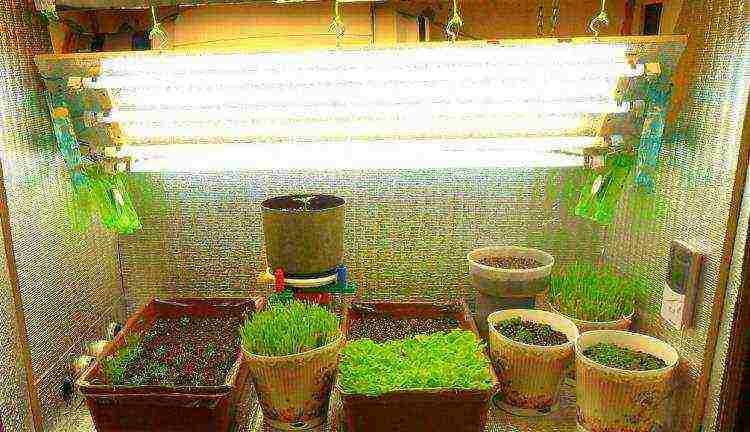
Light characteristics
It is a mistake to assume that flowers only need bright sunlight. In addition to chlorophyll, foliage contains carotenoids, which are also involved in the process of photosynthesis. They absorb the rays of the blue and violet spectrum, which prevail on cloudy days.
Blue and purple colors are needed primarily for adult plants. But young shoots need more red and orange, it is also required to grow young seed shoots. Red light helps root development and fruit ripening. Thus, it becomes clear that for the full life of indoor plants, they need additional lighting, which will provide all the colors of the spectrum.
An important parameter is the already mentioned suites (Lx), which characterize the level of illumination. The luminous flux of a lamp is measured in lumens (Lm), the higher this indicator, the brighter the lamp. These indicators correlate as follows: a light source with a flux of 1 lm, illuminating a surface of 1 square meter, creates an illumination of 1 lx.

Types of lamps
Depending on the above indicators, you need to choose a suitable lamp. Growing plants under artificial lighting is carried out using fluorescent, LED and incandescent lamps. Let's compare the advantages and disadvantages of each type.
Incandescent lamps
Well-known bulbs seem to be the simplest and most optimal way to supply additional light. However, it is strictly forbidden to include them alone. There are no blue and violet colors in the spectrum of ordinary bulbs. They create additional heat and dry out the shoots. They cannot be placed at a height below 1 m - this will lead to leaf burns. Suspension above 1 m is also impractical, as the required level of illumination will not be achieved.
There are the following types of incandescent lamps:
- halogen - inside a mixture of xenon and krypton, provides brighter light;
- neodymium - inside contains neodymium, which absorbs the yellow-green part of the spectrum.
These improvements do not make the incandescent lamp more effective for supplemental lighting in plants. In addition, their light output is too low - 17-25 lm / W.

Fluorescent lamps
One of the most common types of lighting fixtures among florists. It gives the necessary colors of the spectrum - blue and red. The undoubted advantage is durability in use and low cost. There are several types of fluorescent lamps:
- general purpose;
- special purpose;
- compact.
General purpose lamps are used for both indoor lighting and decorative flowers, and can be used to provide additional light for aquarium plants. High luminous efficiency of 50-70 lm / W, low heating capacity and durability serve as a good characteristic for such lamps.
Special bulbs differ from the previous ones in that a special type of phosphor is applied to the surface of the bulb, which makes the light as close as possible to the desired spectral value. Thus, it is advisable to use special-purpose lamps to illuminate ornamental plants.
Compact bulbs are suitable for illuminating a single plant; they cannot be used in greenhouses. They are easy to install; during installation, it is enough to simply screw them into the plafond. Among the disadvantages is a low power of 20 W, which means that it can be used only for one copy, hanging at a height of about 30-40 cm.

There are small phyto-bulbs with increased power that can be used together with a reflector to illuminate a small greenhouse. Their power is 36-55 W, the spectrum contains red and blue colors. Among the disadvantages is the high price.
Discharge lamps
An excellent solution for lighting greenhouses or greenhouses. High-pressure gas-discharge phytolamps are connected to the power grid through a special ballast. They are small in size, but at the same time give a lot of illumination. There are three types:
- mercury;
- sodium;
- metal halide.
Mercury lamps are practically out of use among florists. Due to the special coating inside the bulb, they have an unpleasant blue glow and low light output.
A sodium lamp with a built-in reflector has the amazing ability to illuminate an entire greenhouse or conservatory. Light output is very high, and the duration of continuous operation is 12-20 thousand hours. The disadvantage is the predominance of red spectral colors, therefore, for full illumination, it is better to use another lamp that compensates for the lack of blue color.
The most optimal among gas-discharge lamps is metal halide. It has a spectrum suitable for colors, high luminous efficiency and high power. The only drawback is the high cost. In addition, a special cartridge is required for installation.
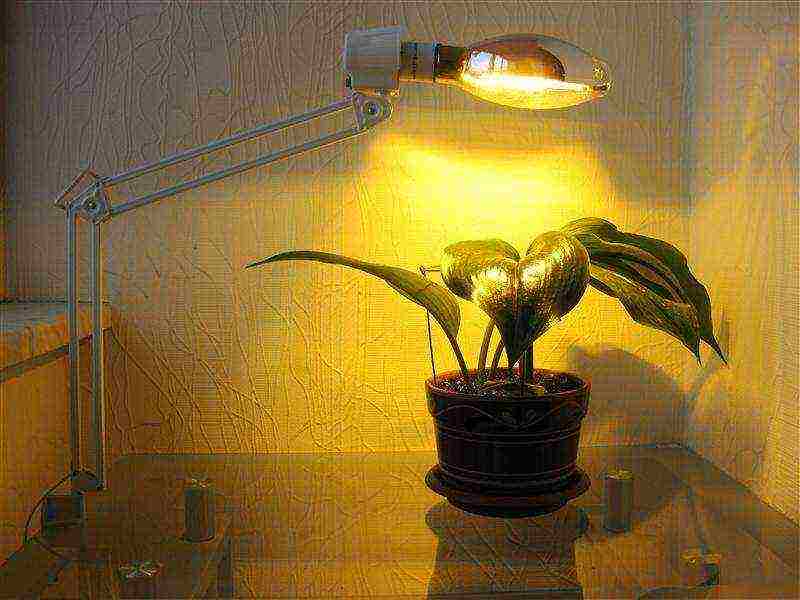
LED bulbs
It is worth saying that the word "light bulb" does not quite fit with LED lamps. First of all, it is a solid-state semiconductor device that is absolutely safe to use, because there are no dangerous gases or mercury in the composition.
Light is generated by an electric current that passes through a crystal installed inside. All energy is spent on receiving light, which means that the device itself does not heat up, which is very important for flowers.
LED lighting for indoor plants is considered to be optimal in terms of its characteristics. First, the device can operate for several years if it is switched on continuously. Secondly, there is no infrared and ultraviolet radiation in the spectrum, which means that the lamp is safe for people and other living beings.
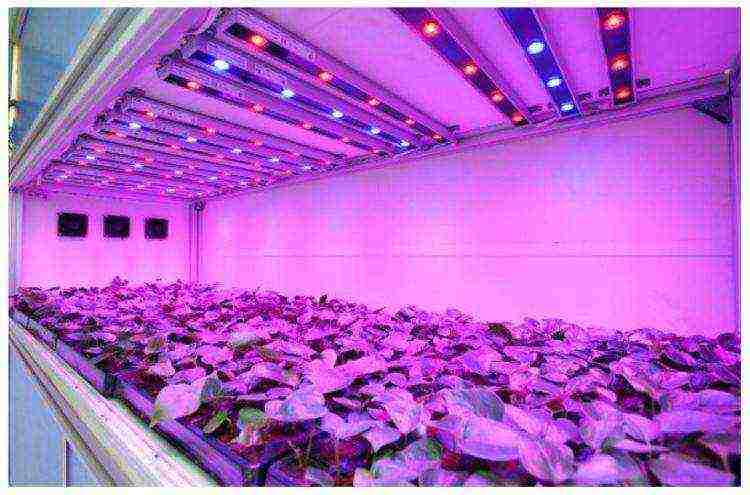
The color depends on the crystal placed inside the device. There are some lamps that contain several crystals, they simultaneously provide several spectral colors. You can adjust the brightness of an individual LED by changing the amperage. LED devices are easy to install with your own hands; this does not require special knowledge and skills of an electrician.
The only drawback of LED lighting is the high cost of lamps. But this disadvantage is completely offset by the advantages of LED lamps.
Each grower decides for himself which type of additional lighting he should choose. Knowing the advantages and disadvantages of each type of lamp will help you make the right choice. Based on the information available at the moment, LED devices are considered the most optimal among plant breeders.
Every experienced florist knows what a huge role the right lighting for indoor plants plays. Along with watering and soil, light is an indispensable component on which successful growth directly depends.It is no secret that in the natural environment, some plants thrive in shaded areas, while others cannot develop without direct exposure to sunlight. At home, the situation looks similar. We will talk in detail about how to correctly make artificial lighting for indoor plants.
Decorative and plant growth lighting
A bulb for growing indoor plants is a great way to extend daylight hours. After all, many indoor flowers are of tropical origin, which means that they experience a lack of solar energy every day, especially in winter. For effective plant growth, the duration of daylight hours should be about 15 hours. Otherwise, they weaken, stop blooming and undergo various diseases.
When planning the future illumination of indoor flowers, it is important not to miss out on the aesthetic component. The phyto-lamp should become a part of the interior, a kind of decor element. On sale there are a huge number of wall-mounted luminaires of various shapes, for any energy-saving lamp: CFL or LED. Depending on the size of the home flower garden, the backlight can be made from several spot lamps aimed directly at each green pet, or from tubular fluorescent lamps with a reflector. By connecting your own imagination, you can make an original LED phyto-lamp yourself.
The most important component of growth is the light spectrum
In order to understand how heterogeneous the light from different electrical sources and the sun is, it is necessary to look at their spectral composition. The spectral characteristic is the dependence of the radiation intensity on the wavelength. The solar radiation curve is continuous over the entire visible range with a decrease in the UV and IR regions. The spectrum of artificial light sources in most cases is represented by individual impulses of different amplitudes, which as a result gives the light a certain shade.
During the experiments, it was found that for the successful development of plants, not the full spectrum is used, but only its individual parts. The following wavelengths are considered the most vital:
- 640–660 nm - a velvety red color, necessary for all adult plants for reproductive development, as well as for strengthening the root system;
- 595-610 nm - orange for flowering and ripening of fruits;
- 440–445 nm - violet for vegetative development;
- 380–400 nm - near UV range to regulate the growth rate and protein formation;
- 280-315 nm - mid-UV range to increase frost resistance.
Illumination with only the listed rays is not suitable for all plants. Each representative of the flora is unique in its “wave” preferences. This means that it is impossible to fully replace the energy of the sun with the help of lamps. But artificial lighting of plants in the morning and evening hours can significantly improve their life.
Signs of a lack of light
There are a number of signs by which it is easy to identify a lack of light. You just need to take a close look at your flower and compare it with the standard. For example, find a similar look on the Internet. A clear lack of illumination is manifested as follows. The plant slows down its growth. The new leaves are smaller and the stem becomes thinner. The lower leaves turn yellow. The flower either stops blooming completely, or the number of buds formed is less than the average. At the same time, it is considered that watering, humidity and air temperature are normal.
How much light do you need?
It is impossible to give an unambiguous answer to this question. As a person can live in different parts of the globe, so an indoor flower can grow on a windowsill with access to the north, south, west or east.The plant throughout its life will strive to adapt to the current conditions: to stretch upward from a lack of illumination, or, conversely, to expose the next blossoming bud to the sun's rays.
By observing the appearance of the stems and leaves, the size and number of flowers, it is possible to determine the sufficiency of the lighting level. At the same time, do not forget about what stage of development the indoor flower is at: vegetation, flowering, seed ripening. At each of the stages, he takes from the sun the light of the wavelength that he needs at the moment. Therefore, when organizing additional lighting, it is important to take into account the quality component of the luminous flux.
Prolonged exposure to the bright light of the sun and lamps with an illumination level of more than 15 thousand lux are loved by those indoor flowers that grow in their natural habitat in the open air. This is a favorite of many Crassula, geranium, Kalanchoe, begonia. Artificial lighting for plants of this type in the evening will benefit them.
Representatives of the flora that feel comfortable under illumination of 10-15 thousand lux include spathiphyllum, clivia, saintpaulia, tradescantia and dracaena. The leaves of these types of indoor flowers do not like hot sunlight, but they also do not tolerate early twilight. Therefore, the ideal place for them would be a window sill with an exit to the west, where in the evening their leaves will receive the necessary energy from the setting sun.
The so-called shade-loving plants can bloom and develop far from the window opening, being content with illumination up to 10 thousand lux. However, this does not mean that they will die if they are placed in a brighter place. They just need less direct sunlight. These include some types of ficus and dracaena, philodendron, and tropical vines.
Supplementary lighting of plants and artificial light sources
In most cases, indoor plants need additional lighting. Flowers, which at first glance have bright green succulent leaves and bloom regularly, will look even better if you begin to influence them with a phytolamp. If someone thinks differently, then he has a great chance to make sure that his thinking is wrong and to assemble a phyto-lamp with his own hands. Various artificial light sources are used to extend daylight hours. Let's take a look at each of them and figure out which light is best for plants.
Incandescent lamps
 Illuminating plants with incandescent bulbs is the least effective for several reasons. The radiation spectrum of ordinary bulbs with a spiral is strongly shifted to the red region, which does not contribute to photosynthesis in any way. Low efficiency and, as a result, huge heat release drive their energy and luminous efficiency to zero. In addition, incandescent lamps are characterized by the shortest service life in comparison with other artificial light sources.
Illuminating plants with incandescent bulbs is the least effective for several reasons. The radiation spectrum of ordinary bulbs with a spiral is strongly shifted to the red region, which does not contribute to photosynthesis in any way. Low efficiency and, as a result, huge heat release drive their energy and luminous efficiency to zero. In addition, incandescent lamps are characterized by the shortest service life in comparison with other artificial light sources.
Fluorescent lamps
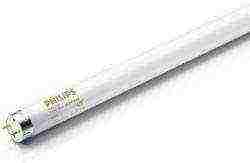 Tubular fluorescent or, as they are most often called, energy-saving full-spectrum T8 daylight lamps (T = 5300–6500 ° K) have been considered the best option for illuminating indoor plants for many years. They have earned a lot of positive reviews due to their selective spectrum, economy and low heat dissipation, combined with an acceptable cost.
Tubular fluorescent or, as they are most often called, energy-saving full-spectrum T8 daylight lamps (T = 5300–6500 ° K) have been considered the best option for illuminating indoor plants for many years. They have earned a lot of positive reviews due to their selective spectrum, economy and low heat dissipation, combined with an acceptable cost.
Companies specializing in the production of fluorescent lamps offer plant breeders an improved version - a phytolamp with a selective radiation spectrum. They work mainly in the blue and red ranges, which can be seen from the characteristic glow. But the cost of such lamps for plant illumination is an order of magnitude higher than conventional counterparts.
HPS
 A sodium lamp is the most efficient light source. In terms of light output and working life, these lamps are comparable to LEDs for plants.But they are not suitable for home conditions due to the excessively high brightness (more than 15 thousand lux). But in many greenhouses and greenhouses, growing plants under artificial lighting is based precisely on gas-discharge lamps. Due to the fact that they emit more red light, they are installed in combination with 6500K fluorescent lamps.
A sodium lamp is the most efficient light source. In terms of light output and working life, these lamps are comparable to LEDs for plants.But they are not suitable for home conditions due to the excessively high brightness (more than 15 thousand lux). But in many greenhouses and greenhouses, growing plants under artificial lighting is based precisely on gas-discharge lamps. Due to the fact that they emit more red light, they are installed in combination with 6500K fluorescent lamps.
LED light sources
 All LED phyto-luminaires are divided into three groups:
All LED phyto-luminaires are divided into three groups:
- bicolor;
- with multispectrum;
- with a full range.
Bicolor or bi-color luminaires are based on blue (440–450 nm) and red (640–660 nm) LEDs. Their light is considered to be the most optimal for organizing the illumination of any plants during the growing season. The specified working spectrum favors the process of photosynthesis, which leads to an accelerated growth of the green mass. That is why summer residents prefer blue-red LED lamps when growing seedlings of vegetable crops on the windowsill.
LED lamps with multispectrum have a wider application due to the expansion of the red range into infrared and yellow light. They are in demand for illumination of adult plants, stimulating flowering and ripening of fruits. In an apartment environment, it is better to use an LED multispectrum for flowers with a dense crown.
On a phyto-lamp with a full spectrum of radiation, you can make an illumination for flowers in an apartment, regardless of the type and location. It is a kind of versatile artificial light source that emits in a wide range with peaks in the red and blue zone. The full spectrum LED luminaire is a tandem of energy efficiency and light energy reminiscent of the sun's rays.
Today, the creation of favorable conditions for an extensive transition to phyto-LEDs does not occur for two reasons:
- the high cost of quality plant lamps;
- a large number of fakes collected on conventional LEDs.
Which light is best for growth?
Solar energy is certainly the ideal light source. In apartments with windows to the southeast and southwest, you can grow any flowers by placing them at different points in the room. But do not be upset for those who have a view from the window only to the north side. Fluorescent and LED plant lamps compensate for the lack of sun rays.
Daylight plant lamps are a time-tested budget option. They are suitable for those who are trying to create normal conditions for a flower with a small investment. LED phytolamps for those who seek to force events and achieve the best results in a short time, despite the price of several thousand rubles.
5 useful tips
- Before buying another "leafy pet", you should find out how photophilous it is. Perhaps the allotted place in the room will not be able to provide him with full development.
- An inexpensive option for illuminating light-loving plants can be made from an 18 W fluorescent lamp and a 25 W incandescent lamp.
- The prevailing radiation in the yellow region of the visible spectrum inhibits the growth of stems. Backlighting the dracaena (and other tree species) with warm light will give it a compact shape.
- If a plant with variegated foliage loses its original color and becomes monochromatic, then it clearly lacks light. The LED phytolamp will help to return the flower to its former attractiveness.
- The light from red and blue LEDs accelerates eye fatigue. In this regard, visual work in the area of their action should be excluded.
Summing up
We hope that the material read has helped the reader to master the basic knowledge of organizing lighting for flowers in the house and on the balcony. Once again, I would like to emphasize the economy and high efficiency of LED lamps for growing plants, a massive transition to which is just around the corner.Let every florist who has the opportunity today to purchase a phyto-lamp with LEDs evaluate its power and leave a review for other readers in the comments below.


